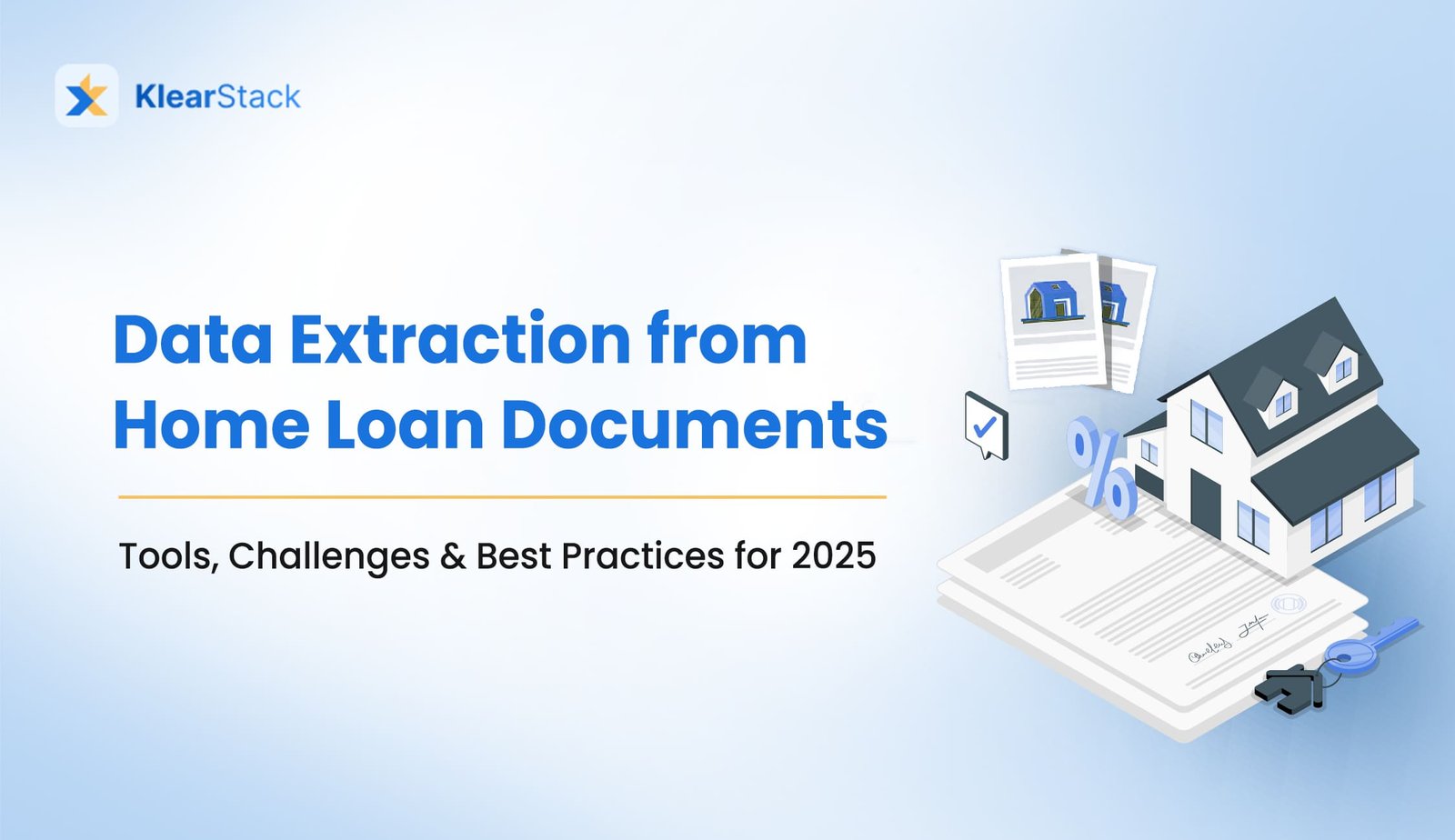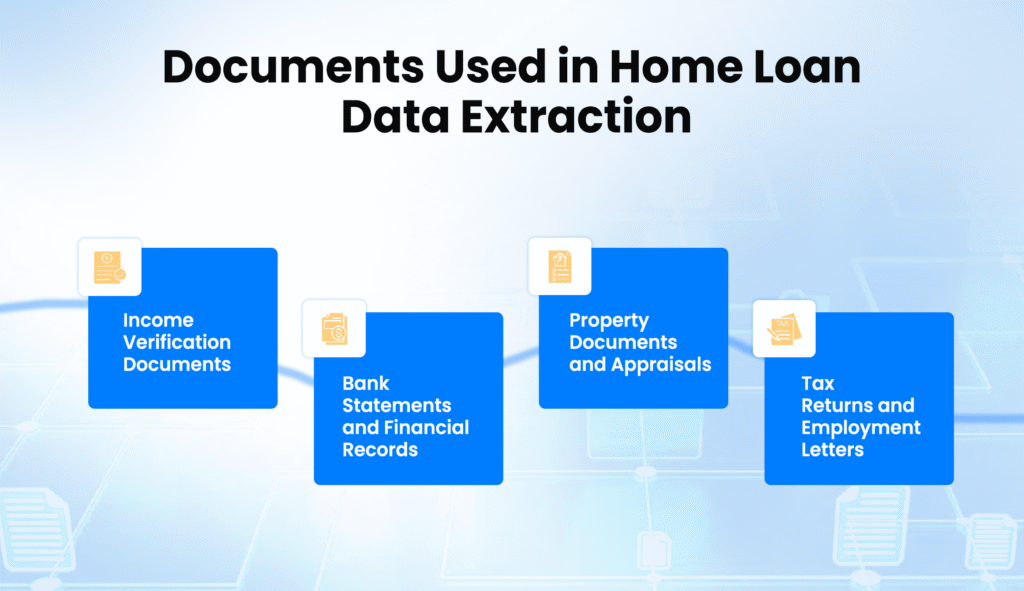Data Extraction from Home Loan Documents: Tools, Challenges & Best Practices for 2025

A typical mortgage application includes over 300 pages of documentation from bank statements to property titles (McKinsey, 2024). Manual processing of such high-volume data slows down operations, increases error rates, and risks non-compliance.
- Are your loan officers spending hours retyping instead of reviewing applications?
- Is your document verification process delaying approvals and hurting customer experience?
- Can you trust your current system to extract data from complex scanned PDFs accurately?
Modern lending institutions can’t afford these gaps. In this blog, we’ll explain how automated data extraction from home loan documents helps solve these problems with high accuracy and speed without compromising security or compliance.
Let’s explore how intelligent data extraction transforms home loan processing, reduces operational costs, and helps financial institutions make faster, more informed lending decisions.
Key Takeaways
- Home loan documents contain unstructured data that slows down loan approval cycles.
- Automated data extraction converts PDFs and scans into structured data instantly.
- OCR, AI, and RPA are key to handling multiple document formats.
- Institutions using automation see 70% faster processing and 80% lower manual effort.
- Best practices improve accuracy, security, and system performance.
What is Data Extraction from Home Loan Documents?

Data extraction from home loan documents means converting raw document data into structured digital formats. It helps financial institutions process mortgage applications faster and more accurately.
For example, data from a pay stub or tax return is automatically pulled, cleaned, and entered into the loan origination system without manual typing.
Critical Document Categories:
- Income verification documents (W-2s, 1099s, pay stubs)
- Bank statements and financial records
- Property documentation and appraisals
- Credit reports and history
- Employment verification letters
- Tax returns and financial statements
- Insurance documentation
- Property titles and deeds
This process enables faster decisions, better risk checks, and fewer rejections due to errors.
Documents Used in Home Loan Data Extraction

Financial institutions verify a borrower’s background through various document types. Each carries specific data fields used in risk analysis.
Income Verification Documents
These include pay stubs, W-2s, and 1099 forms.
They reveal monthly and annual income, tax deductions, and employment history.
Lenders use this data to calculate income-to-loan ratios and determine repayment capacity.
Bank Statements and Financial Records
Bank statements show spending patterns, balances, and savings history.
Lenders check for stable income, overdrafts, and recurring payments.
This data supports real-time financial health assessments.
Property Documents and Appraisals
These include title deeds, appraisal reports, and ownership verification documents.
They confirm property value and legal status to mitigate lending risks.
Digital extraction from scanned property papers helps speed up approvals.
Tax Returns and Employment Letters
Borrowers often submit ITR filings, employer verification letters, or Form 16 equivalents.
These validate long-term income and employer status, especially for salaried individuals.
OCR systems are trained to detect and process these varying formats.
How Automated Extraction Works for Home Loan Documents?
Modern extraction solutions combine artificial intelligence and machine learning to identify, capture, and validate data from loan documents.
The technology recognizes various document types, locates relevant fields, and extracts information with minimal human intervention.
Automation tools read and process mortgage documents in three structured stages:
- Document classification – Recognize the document type (e.g., pay stub, credit report)
- Field identification and extraction – Pull out relevant data points
- Data validation – Check values against rules, then export to backend systems
These steps allow large volumes of documents to be processed with minimal manual input.
Systems also support:
- Multilingual recognition
- Format-agnostic inputs (PDFs, scans, images)
- Instant flagging of missing data
Automation cuts delays while ensuring compliance and consistency.

Role of OCR in Extracting Data from Home Loan Documents
Optical Character Recognition (OCR) technology forms the foundation of automated data extraction. Advanced OCR software convert printed and handwritten text from home loan documents into machine-readable data, enabling further processing and analysis.

OCR Processing Steps:
- Document Preprocessing and Image Enhancement: Optimizes document quality by adjusting brightness, contrast, and removing noise. This step ensures even poor-quality scans become readable for accurate extraction.
- Text Recognition and Character Extraction: Converts visual text elements into machine-readable characters. The system identifies and interprets both printed and handwritten text while maintaining contextual accuracy.
- Layout Analysis and Field Mapping: Identifies document structure, locates key fields, and understands relationships between data elements. This step determines where specific information resides and how it connects to other fields.
- Data Structuring and Validation: Organizes extracted data into structured formats while verifying accuracy against predefined rules. Cross-references information across fields to ensure data consistency and completeness.
- Format Conversion and Export: Transforms validated data into your required output format for seamless integration. Supports various export options that align with your existing loan processing systems.
- Quality Assurance Checks: Performs automated accuracy verification and flags potential issues for review. This final step ensures extracted data meets quality standards before entering your workflow.
Modern OCR solutions achieve over 99% accuracy through continuous learning and refinement. The technology handles various document formats, including:
- Scanned paper documents
- Digital PDFs
- Mobile phone images
- Faxed documents
- Email attachments
This high precision ensures reliable data extraction from even the most complex home loan documents while maintaining data integrity.
Technologies Used in Home Loan Data Extraction
Multiple tools work together in automated lending workflows. Each plays a specific role in capturing, cleaning, and verifying data.
OCR
Captures data from scanned and digital documents.
Supports both printed and handwritten text.
AI and ML
Artificial Intelligence understands context and meaning in mortgage data.
Machine Learning adapts to new document formats over time.
AI helps:
- Classify documents
- Detect anomalies
- Predict loan risk
Robotic Process Automation (RPA)
RPA automates repetitive tasks like logging into portals or copying data.
It reduces manual effort and integrates with credit rating sites or government APIs.
Document Management Systems (DMS)
DMS stores all documents securely.
It provides:
- Version control
- Easy retrieval
- Access audit trails
Classification APIs
These detect document types, pages with errors, or missing pages.
They support compliance and process automation across large volumes.
Common Challenges in Data Extraction for Home Loans
Despite automation, institutions still face practical issues when processing mortgage documents.
- Incomplete or outdated documents cause data mismatches
- Multiple file formats (images, PDFs, spreadsheets) require flexible input handling
- Legacy system integration limits speed and compatibility
- Security concerns like data leakage or unauthorized access must be prevented
- Regulatory risks increase with non-compliant storage or audit gaps
Addressing these requires modular systems, clear validation rules, and encrypted storage.

Best Practices for Reliable Data Extraction
To extract high-quality data from loan documents, follow these tested methods:
- Use pre-validation filters to reject incomplete documents early
- Set up field-specific accuracy rules to avoid bad extractions
- Regularly update extraction templates and AI models
- Limit document access by role and function
- Monitor real-time performance metrics across all extraction stages
These steps reduce approval delays and help maintain compliance under laws like GDPR and DPDPA.
Why Should You Choose KlearStack?
KlearStack transforms home loan document processing with an AI-powered platform built specifically for mortgage operations. Our specialized solution understands the context and relationships in loan documents that generic systems miss.
Through deep learning and natural language processing, we interpret complex mortgage documentation with unprecedented accuracy. Our system achieves 99% accuracy even with poor-quality scans and complex home loan documents.
Advanced Intelligence Features:
- Contextual data interpretation
- Cross-document relationship mapping
- Automated insight generation
- Pattern recognition
KlearStack processes home loan documents with deep contextual understanding, not just basic data extraction. Our AI and NLP engines interpret complex financial relationships, identify key patterns, and flag potential issues automatically.
Key Features of KlearStack that makes it stand out:
- Template-free data extraction: Extract data from any document, any format, and adapt business intelligence of highest level.
- Self-Adaptive Models: Processes even entirely new document formats with remarkable accuracy, outperforming traditional solutions.
- Supports All Document Types: Handles a wide range of formats, from invoices to credit notes, ensuring versatility across departments.
We invite you to witness how KlearStack transforms mortgage document processing. Schedule a personalized demonstration to see our system handle your actual home loan documents.
Our team will discuss your specific needs, potential efficiency gains, and implementation approach.
Take the next step toward modernizing your loan document processing. Book a demonstration to discover how KlearStack becomes your trusted partner in mortgage automation.
Ready to transform your home loan processing? Book a Free Demo Call today!
Conclusion
Automated data extraction fundamentally transforms home loan processing by eliminating manual entry, reducing errors, and accelerating decisions. Financial institutions implementing these solutions gain significant competitive advantages through faster processing, lower costs, and improved customer experience.
Key Success Factors:
- Clear implementation strategy
- Strong vendor partnership
- Comprehensive staff training
- Regular performance monitoring
- Continuous optimization
The future of mortgage processing lies in automation. Financial institutions that embrace this technology now will lead the industry in processing speed, accuracy, and customer satisfaction. Your investment in automated data extraction today builds the foundation for tomorrow’s lending success.
FAQs on Home Loan Data Extraction
The types of data that can be extracted include:
– Applicant details (name, address, ID numbers).
– Loan terms (amount, tenure, interest rate).
– Supporting documents (income proof, credit scores).
The risks of paper-based processes include:
– Data loss or theft due to poor security.
– Non-compliance with regulations like GDPR or DPDPA.
– Delays and errors in manual handling.
The benefits of AI-powered data extraction include:
– Faster processing and reduced manual effort.
– Higher accuracy, minimizing loan approval errors.
– Improved compliance and data security.
Yes, many providers offer free trials or demos.
– Demos showcase core features and capabilities.
– Trials help test software with actual documents.
– Verify solution compatibility before purchase.


